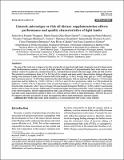Por favor, use este identificador para citar o enlazar a este item:
http://hdl.handle.net/10261/295244COMPARTIR / EXPORTAR:
 SHARE SHARE
 CORE
BASE CORE
BASE
|
|
| Visualizar otros formatos: MARC | Dublin Core | RDF | ORE | MODS | METS | DIDL | DATACITE | |

| Título: | Linseed, microalgae or fish oil dietary supplementation affects performance and quality characteristics of light lambs |
Autor: | Fuente, Jesús M. de la CSIC ORCID; Díaz Díaz- Chiron, María Teresa; Pérez-Marcos, C.; Cañeque, V.; Sánchez-González, C. I.; Álvarez Acero, Inmaculada CSIC ORCID; Fernández-Bermejo, C.; Rivas-Cañedo, A.; Lauzurica, S. | Palabras clave: | Light lamb Lipid oxidation n-3 polyunsaturated fatty acids colour stability |
Fecha de publicación: | 2014 | Editor: | CSIC - Instituto Nacional de Investigación y Tecnología Agraria y Alimentaria (INIA) | Citación: | Spanish Journal of Agricultural Research 12(2): 436-447 (2014) | Resumen: | The aim of this work was to improve the fatty acid profile of meat from light lamb, frequently reared in Spain and in other Mediterranean countries. A total of 44 light lambs fed different n-3 polyunsaturated fatty acids sources were studied control (C) (palm oil), extruded linseed (L), extruded linseed mixed with microalgae (LM) and fish oil (FO). The productive performance from 14.7 to 26.2 kg of live weights and meat quality characteristics during refrigerated storage were assessed. Lambs fed FO showed lower feed intake (p < 0.001), average daily gain (p < 0.001) and higher feed conversion ratio (p < 0.001) than lambs from the other treatments. Fish oil meat had the lowest (p < 0.01) protein proportion and the highest (p < 0.001) C205n-3, C225n-3 and C226n-3 proportions, while L or LM produced the highest (p < 0.001) C183n-3 deposition. Fish oil meat had higher (p < 0.05) L* and lower (p < 0.001) a* than meats from the other treatments. After 7 days of storage, FO meat showed the highest TBARS (p < 0.001), while C meat showed similar value to 0 days of storage. Additionally, FO underwent higher microbial growth after 7 days of storage as compared to the other treatments. Dietary supplementation with L and LM leads to C183n-3 meat enrichment and to a microbial load and colour characteristics similar to those of C, without adverse effect on lamb performance. However the use of FO improves the fatty acid profile of meat, but negatively affects lamb performance and meat quality. | URI: | http://hdl.handle.net/10261/295244 | DOI: | 10.5424/sjar/2014122-4639 | ISSN: | 1695-971-X | E-ISSN: | 2171-9292 |
| Aparece en las colecciones: | (INIA) Artículos |
Ficheros en este ítem:
| Fichero | Descripción | Tamaño | Formato | |
|---|---|---|---|---|
| 1047.pdf | 145,21 kB | Adobe PDF |  Visualizar/Abrir |
CORE Recommender
SCOPUSTM
Citations
26
checked on 30-abr-2024
WEB OF SCIENCETM
Citations
19
checked on 29-feb-2024
Page view(s)
41
checked on 07-may-2024
Download(s)
20
checked on 07-may-2024
Google ScholarTM
Check
Altmetric
Altmetric
Este item está licenciado bajo una Licencia Creative Commons

